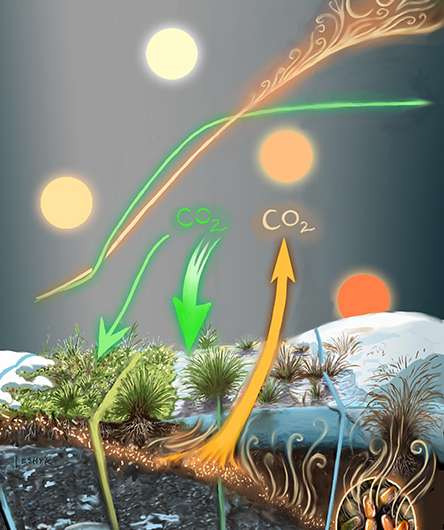Tundra loses carbon with rapid permafrost thaw

Frozen in permafrost soil, northern latitudes store almost twice as much carbon as is currently in the atmosphere. Rapid Arctic warming is expected to expose previously frozen soil carbon to microbial decomposition and increase carbon dioxide release. The impact on the carbon dioxide balance is, however, unclear.
Why? Because warmer temperatures and nutrients released from thawing permafrost increase plant growth and could offset carbon dioxide losses. We examined the effect of warmer air and the effect of warmer soil and permafrost thaw on tundra ecosystem carbon dioxide. Seven years of experimental study show that summer plant growth did not, in the longer term, take up as much carbon as was lost by soil warming and permafrost.
Models and observations currently disagree over how Arctic warming will affect the carbon dioxide balance of tundra ecosystems. Few studies combine warmer air and permafrost thaw to evaluate the ecosystem carbon dioxide balance. This work shows that tundra carbon dioxide uptake and loss responded much more strongly to permafrost thaw than to warmer air alone. Rapid permafrost thaw did initially stimulate carbon dioxide uptake during the summer. However, uptake leveled off with very deep thaw. In all years of the experiment, summer carbon dioxide uptake was insufficient to offset year-round carbon dioxide losses.
Seven years of experimental air and soil warming in tundra show that soil warming and permafrost thaw had a much stronger effect on carbon balance than air warming. Permafrost thaw initially stimulated greater summer carbon dioxide uptake than carbon dioxide loss; however, the initial increases were not sustained. As thaw continued to progress, summer carbon dioxide uptake and carbon dioxide loss leveled off. Leveling off carbon dioxide uptake and release could be explained by the slowing of plant growth and greater soil saturation as thaw caused the ground surface to collapse. The complex interactions between permafrost thaw, plant growth, and soil moisture could be captured mathematically by a quadratic relationship showing that the effect of thaw on carbon dioxide uptake and loss changed over time. Models and measurements used to estimate carbon dioxide losses during the winter found that the tundra was losing carbon dioxide on an annual basis, even during those summers when thaw stimulated high plant growth and carbon dioxide uptake.
More information: Marguerite Mauritz et al. Nonlinear CO2 flux response to 7 years of experimentally induced permafrost thaw, Global Change Biology (2017). DOI: 10.1111/gcb.13661
Journal information: Global Change Biology
Provided by US Department of Energy


















